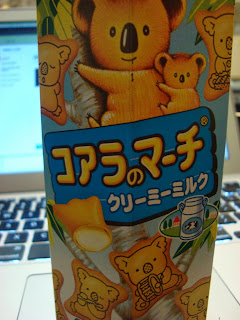(A) Sample 1
This is a dictionary of Japanese writers' pen names. As "pen name" is a foreign word, so katakana is used here-"ペンネーム." Also, アニメis a foreign word "animation." And Katakana is used. I choose the page about "手塚治虫" who is the writer of アトム. Noticing that "アトム" is in Katakana, I think maybe the writer wants to emphasize アトム's importance as he is the hero of the comic book. Maybe he wants to show the sound of his hero's name and makes アトム be special.Generally, I think this is アトムis the author's preference.
(B) Sample 2
This is a box of biscuits. All biscuits are in shape of koala. First, the katakana "コアラ" describes the foreign word "koala." Second, “マーチ” describes the English word "match"in music. Thus, this is still a foreign word. Third, "クリーミーミルク" describe the foreign words "creamy milk." Does this mean that katakana which is used to describe foreign words occupies a large proportion? Also I am curious whether Katakana used in ads seems to be more fashionable. Considering the background introduced by tatsumi sensei in class, I have another guess. In the history, Katakana was used by men who were considered knowledgable. I guess that using katakana may seem to be superior and cultured?
(C) Sample 3
グミis soft candies. Maybe katakana which is used here is to emphasize, because this is a brand and tries to catch people's attention. "マンゴスチン" just describes the foreign word mangosteen which is a kind of fruit. Or maybe this katakana word can be explained by using the explanation that "to write the name of an animal, plant, disease, tool,etc. (Applies mainly where pertinent kanji are not included in the Joo-yoo-Kanji list)" (On Katakana). I think the グミ is a little different from the text descriptions of katakana. Besides emphasis, it seems that there is no reason to use katakana to describe candies.




Hi, Liu san!
ReplyDeleteNice samples! How did you get them? My question is that in the second sample, does "マーチ" mean march instead of village(まち)? I don't know because I cannot see the whole packet. In the third sample, "gumi" seems like a newly created word (新造語). I think "gumi" is a new type of treat (gummy candy) as written on the bag. Why don't you google it? Thank you.
Thank you very much! I googled both, and マーチ is match. However, I have new discover about gumi, which actually came from a Germany word pronounce ゴム. Thank you again!
Deleteリウさん、
ReplyDeleteカタカナはおもしろいですね。As you pointed out, Japanese people may think using Katakana words is more fashionable in some context. It would be interesting to ask around situations/contexts where Katakana words sound/look more "fashionable" or "catchy." If people think Katakana words are more fashionable, then do you think people will be using more Katakana words in the future?
TA:さとう
さとおさん、こんばんわ!どうも ありがとう!I do not think more katakana will be used in the future, as kanji, katakana and hiragana actually compete with each other, and as far as I know, hiragana is more related to kanji, so I think maybe for a certain time, one of them might be used more than others, for the long run, katakana will not be used more. Furthermore, I do not hope more katakana will be used in the future, as I feel hiragana is more poetic.
DeleteIt is interesting that they chose to use the katakana for milk instead of the hiragana. Maybe it has to do with the fact that they are translating "creamy milk" instead of just "milk?" I agree that pen-name is a loanword. I also think that you have some good guesses as to the purpose of アトム's name being in katakana.
ReplyDeleteGood point! I do not notice that milk has two pronounces in katakana as well as hiragana. I think you are right, translation is here. Thank you very much!
DeleteYou did a good job relating for each sample how katakana is used in textbooks. I think that some of your questions about the koala biscuits and the candy can be better explained when you look at their target audiences. Who do the makers want to target? Young people, children, adults,etc. (who will be most likely to buy this product?) For example, if this is targeted to children, then does it make sense to use a lot of complicated kanji? Or if it is also targeted for people abroad then will dictating as it sounds in English (using katakana) help? Does the company want to emphasize that the filling is made with "creamy milk" to attract customers?
ReplyDeleteI also agree with your analysis of the first example. Good job :)
Thank you very much! Your question inspires me to think about this sample from another perspective. I think maybe the children are the market target, but I also think that using katakana to translate creamy milk may sound fashionable and western-toward. Thank you again!
ReplyDelete